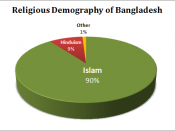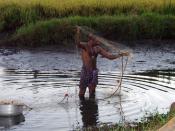The children in Kerala live as long as those in Europe, people in Kerala have managed to conquer hunger and are mostly no longer malnourished; however there are still some who suffer from severe dehydration following diarrhoea. There is a 400% better chance of survival better than those in Bangladesh. The food is shared more equally in Kerala due to food reforms in food distribution. The price of food was kept low, to do this they use Fair Price Food Shop, the government subsidise the price of food. So people learn the value of it, but can still afford it. Kerala has a communist government meaning they help the people and help them equally.
In contrast Bangladesh relies heavily on aid and there is a lot of evidence in the video to support malnutrition, 50,000 children per year go blind due to mineral deficiency. There are many children with hearing and speech defects, and are mentally underdeveloped due to malnutrition, the well off middle classes have subsidised food, housing, education, water, etc.
This means that the people who really need it do not get it, they are subsidised even though they don't need it because they are the ones who keep the government in power.
Bangladesh.
There are huge contrasts in these two countries are poor, densely populated and do not have many work opportunities. The differences occur because in Kerala pressure from the groups supplying the aid meant that their food policies were changed to support the greater good of the population, however in Bangladesh the aid is controlled solely by the government so they give it to those who do not need as much as some, but are more likely to keep the government in power. Bangladesh used to be self sufficient though, until the British colonised it,


